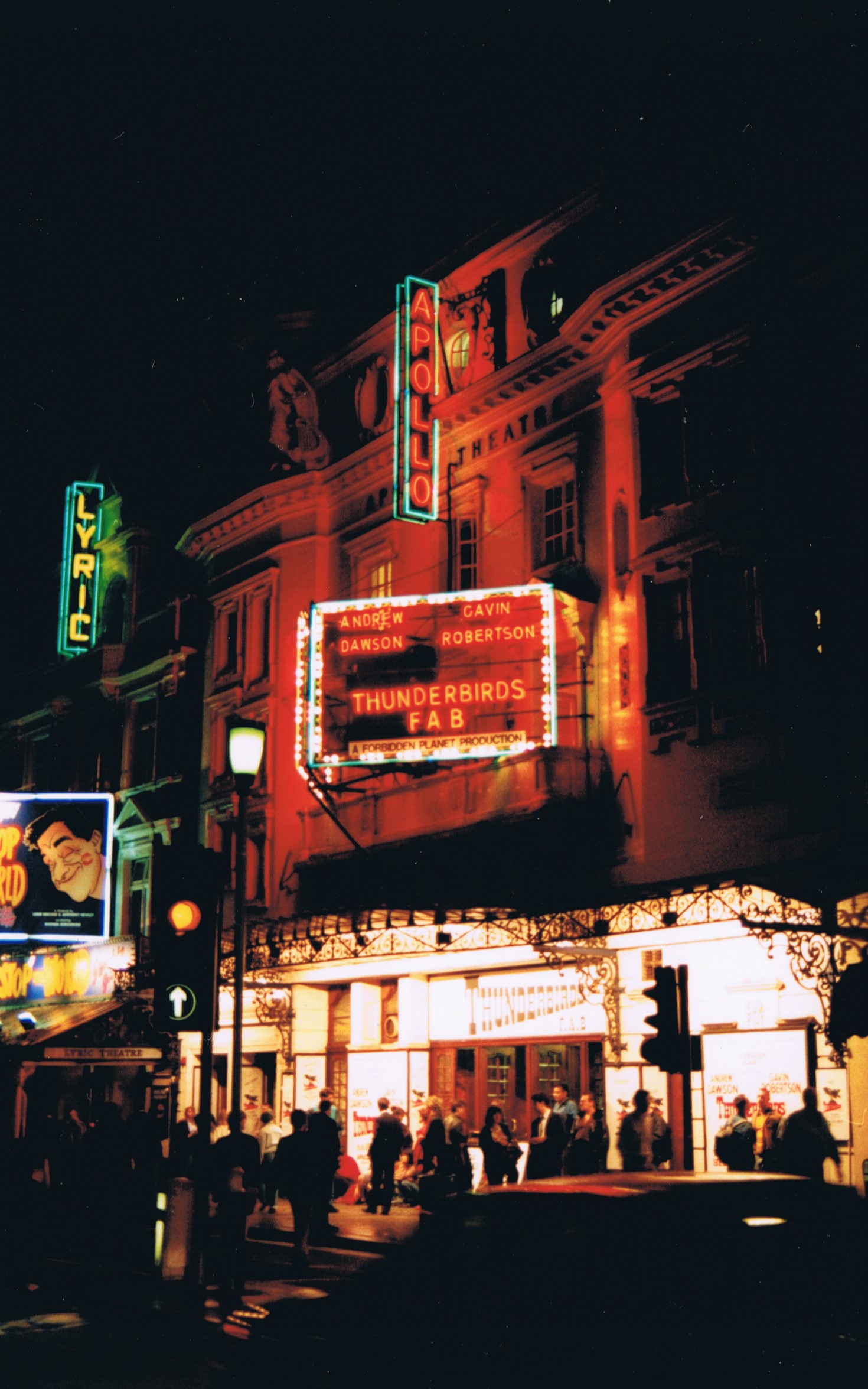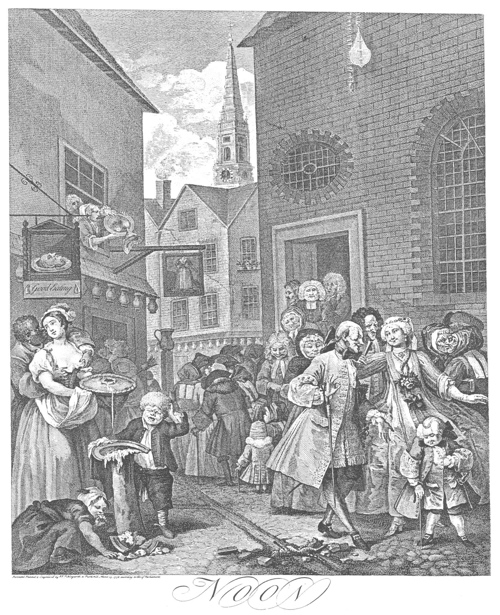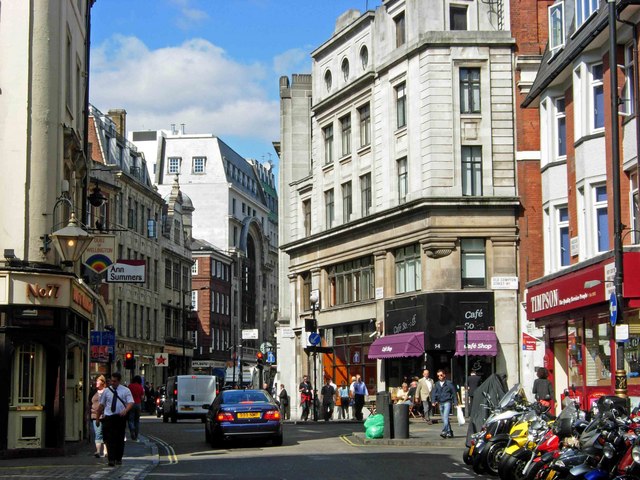|
Shaftesbury Avenue
Shaftesbury Avenue is a major road in the West End of London, named after The 7th Earl of Shaftesbury. It runs north-easterly from Piccadilly Circus to New Oxford Street, crossing Charing Cross Road at Cambridge Circus. From Piccadilly Circus to Cambridge Circus, it is in the City of Westminster, and from Cambridge Circus to New Oxford Street, it is in the London Borough of Camden. Shaftesbury Avenue was built between 1877 and 1886 by the architect George Vulliamy and the engineer Sir Joseph Bazalgette, to provide a north–south traffic artery through the crowded districts of St. Giles and Soho. It was also part of a slum clearance measure, to push impoverished workers out of the city centre. Although the street's construction was stalled by legislation requiring rehousing some of these displaced residents, overcrowding persisted. --> Charles Booth's Poverty Map shows the neighbourhood makeup shortly after Shaftesbury Avenue opened. The avenue is generally considered ... [...More Info...] [...Related Items...] OR: [Wikipedia] [Google] [Baidu] |
London (44761485915)
London is the capital and largest city of England and the United Kingdom, with a population of just under 9 million. It stands on the River Thames in south-east England at the head of a estuary down to the North Sea, and has been a major settlement for two millennia. The City of London, its ancient core and financial centre, was founded by the Romans as '' Londinium'' and retains its medieval boundaries.See also: Independent city § National capitals The City of Westminster, to the west of the City of London, has for centuries hosted the national government and parliament. Since the 19th century, the name "London" has also referred to the metropolis around this core, historically split between the counties of Middlesex, Essex, Surrey, Kent, and Hertfordshire, which largely comprises Greater London, governed by the Greater London Authority.The Greater London Authority consists of the Mayor of London and the London Assembly. The London Mayor is distinguished from the ... [...More Info...] [...Related Items...] OR: [Wikipedia] [Google] [Baidu] |
Apollo Theatre
The Apollo Theatre is a Grade II listed West End theatre, on Shaftesbury Avenue in the City of Westminster, in central London.English Heritage listing accessed 28 April 2007 Designed by the architect for owner , it became the fourth legitimate theatre to be constructed on the street when it opened its doors on 21 February 1901, with the American musical comedy ''< ... [...More Info...] [...Related Items...] OR: [Wikipedia] [Google] [Baidu] |
Chinatown, London
Chinatown is an ethnic enclave in the City of Westminster, London, bordering Soho to its north and west, Theatreland to the south and east. The enclave currently occupies the area in and around Gerrard Street. It contains a number of Chinese restaurants, bakeries, supermarkets, souvenir shops, and other Chinese-run businesses. The first Chinatown was located in Limehouse in the East End. History The first area in London known as Chinatown was located in the Limehouse area of the East End of London. At the start of the 20th century, the Chinese population of London was concentrated in that area, setting up businesses which catered to the Chinese sailors who frequented in Docklands. The area was known through exaggerated reports and tales of slum housing and (the then-legal) opium dens, rather than the Chinese restaurants and supermarkets of the current Chinatown. However, much of the area was damaged by aerial bombing during the Blitz in the Second World War, altho ... [...More Info...] [...Related Items...] OR: [Wikipedia] [Google] [Baidu] |
Greek Street
Greek Street is a street in Soho, London, leading south from Soho Square to Shaftesbury Avenue. The street is famous for its restaurants and cosmopolitan nature. History It is thought to take its name from a Greek church that was built in 1677 in adjacent Crown Street, now part of the west side of Charing Cross Road. The church is depicted in William Hogarth's 'Noon' from ''Four Times of the Day''. Although the street has several houses from the 18th century and earlier, it is mainly 19th-century in appearance. No. 1 Greek Street is the House of St Barnabas, built in 1746. It became the offices of the Westminster Commissioner for Works for Sewers in 1811. This is where Chief Engineer Sir Joseph Bazalgette started to work on the construction of the London sewerage system. By 1862 the house had been taken over by The House of Charity, which was established in 1846 to provide temporary accommodation for homeless people. Charles Dickens used the house and gardens as a model ... [...More Info...] [...Related Items...] OR: [Wikipedia] [Google] [Baidu] |
Wardour Street
Wardour Street () is a street in Soho, City of Westminster, London. It is a one-way street that runs north from Leicester Square, through Chinatown, across Shaftesbury Avenue to Oxford Street. Throughout the 20th century the street became a centre for the British film industry and the popular music scene. History There has been a thoroughfare on the site of Wardour Street on maps and plans since they were first printed, the earliest being Elizabethan. In 1585, to settle a legal dispute, a plan of what is now the West End was prepared. The dispute was about a field roughly where Broadwick Street is today. The plan was very accurate and clearly gives the name ''Colmanhedge Lane'' to this major route across the fields from what is described as "The Waye from Vxbridge to London" ( Oxford Street) to what is now Cockspur Street. The old plan shows that this lane follows the modern road almost exactly, including bends at Brewer Street and Old Compton Street. The road is also a m ... [...More Info...] [...Related Items...] OR: [Wikipedia] [Google] [Baidu] |
Gay Village
A gay village is a geographical area with generally recognized boundaries that is inhabited or frequented by many lesbian, gay, bisexual, transgender, and queer (LGBT) people. Gay villages often contain a number of gay-oriented establishments, such as gay bars and pubs, nightclubs, bathhouses, restaurants, boutiques, and bookstores. Among the most famous gay villages are New York City's Greenwich Village, Hell's Kitchen, and Chelsea neighborhoods in Manhattan; Fire Island and The Hamptons on Long Island; Asbury Park, Lambertville, and Maplewood in New Jersey; Boston's South End, Jamaica Plain, and Provincetown, Massachusetts; Philadelphia's Gayborhood; Washington D.C.'s Dupont Circle; Midtown Atlanta; Chicago's Boystown; London's Soho, Birmingham's Gay Village, Brighton's Kemptown, and Manchester's Canal Street, all in England; Los Angeles County's West Hollywood; as well as Barcelona Province's Sitges, Toronto's Church and Wellesley neighborhood, the C ... [...More Info...] [...Related Items...] OR: [Wikipedia] [Google] [Baidu] |
Great Windmill Street
Great Windmill Street is a thoroughfare running north–south in Soho, London, crossed by Shaftesbury Avenue. The street has had a long association with music and entertainment, most notably the Windmill Theatre, and is now home to the Ripley's Believe It or Not! museum and the Trocadero shopping centre. Early history The street took its name from a windmill on the site which was recorded 1585 and demolished during the 1690s. In a parliamentary survey of 1658 the mill was described as "well fitted with Staves and other materials". The area was developed around 1665 but the building was speculative and of poor quality; this led to a royal proclamation in 1671 that prohibited unlicensed development in "Windmill Fields, Dog Fields and Soho". Later that year, Thomas Panton, one of the original speculators, was granted a licence to continue his scheme with the condition that it was supervised and directed by Sir Christopher Wren who was the Surveyor General of the King's Works. ... [...More Info...] [...Related Items...] OR: [Wikipedia] [Google] [Baidu] |
Asian Martial Arts
There are many distinct styles and schools of martial arts. Sometimes, schools or styles are introduced by individual teachers or masters, or as a brand name by a specific gym. Martial arts can be grouped by type or focus, or alternatively by regional origin. This article focuses on the latter grouping of these unique styles of martial arts. For Hybrid martial arts, as they originated from the late 19th century and especially after 1950, it may be impossible to identify unique or predominant regional origins. It is not trivial to distinguish "traditional" from "modern" martial arts. Chronology is not the decisive criterion, as, for example, "traditional" Taekwondo was developed in the 1950s, while the "modern" hybrid martial art of Bartitsu was developed in ca. 1900. A large portion of traditional martial arts can be categorized as Folk wrestling (see the separate article), although in some cases a folk wrestling style and a modern combat sport may overlap or become indistingu ... [...More Info...] [...Related Items...] OR: [Wikipedia] [Google] [Baidu] |
Bartitsu
Bartitsu is an eclectic martial art and self-defence method originally developed in England in 1898–1902, combining elements of boxing, jujitsu, cane fighting and French kickboxing (savate). In 1903, it was immortalised (as "baritsu") by Sir Arthur Conan Doyle, author of the Sherlock Holmes mystery stories. Although dormant throughout most of the 20th century, Bartitsu has experienced a revival since 2002. History In 1898, Edward William Barton-Wright, an English engineer who had spent the previous three years living in Japan, returned to England and announced the formation of a "New Art of Self Defence". This art, he claimed, combined the best elements of a range of fighting styles into a unified whole, which he had named Bartitsu. Barton-Wright had previously also studied "boxing, wrestling, fencing, savate and the use of the stiletto under recognised masters", reportedly testing his skills by "engaging toughs (street fighters) until (he) was satisfied in their application." ... [...More Info...] [...Related Items...] OR: [Wikipedia] [Google] [Baidu] |
Curzon Cinemas
Curzon Cinemas () are a chain of cinemas based in the United Kingdom, mostly in London, specialising in art house films. They also have a video on demand service, Curzon Home Cinema. History Curzon Cinemas were established in 1934 when Harold Wingate, who imported unknown films during the post World War I period, opened the first cinema in Mayfair. The second location, Curzon Bloomsbury, opened in 1972. In 1976 Curzon Artificial Eye, the film distribution company was launched. On 23 December 2019, American-based Cohen Media Group acquired Curzon Cinemas, including Curzon Artificial Eye. In March 2020, Curzon Cinemas and all other public cinemas in the UK closed until summer 2020 due to a national lockdown in response to the ongoing COVID-19 pandemic. Locations Curzon Cinemas currently have 17 cinema complexes throughout the United Kingdom. Franchised locations Curzon Cinemas have also franchised their name and operate in partnership with a number of other locations. F ... [...More Info...] [...Related Items...] OR: [Wikipedia] [Google] [Baidu] |
Saville Theatre
ODEON Covent Garden is a four-screen cinema in the heart of London's West End. Formerly known as The Saville Theatre, a former West End theatre at 135 Shaftesbury Avenue in the London Borough of Camden. The theatre opened in 1931, and became a music venue during the 1960s. In 1970 it became the two cinemas ABC1 Shaftesbury Avenue and ABC2 Shaftesbury Avenue, which in 2001 were converted to the four-screen cinema Odeon Covent Garden. History Theatre years The theatre was designed by the architect Sir Thomas Bennett, in consultation with Bertie Crewe, and opened on 8 October 1931, with a play with music by H.F. Maltby, ''For The Love Of Mike''.Saville Theatre history at Arthur Lloyd accessed 28 Aug 2008 The theatre benefited from a capacity of 1,426 on three levels and a stage that was wide, with a depth ... [...More Info...] [...Related Items...] OR: [Wikipedia] [Google] [Baidu] |
Shaftesbury Theatre
The Shaftesbury Theatre is a West End theatre, located on Shaftesbury Avenue, in the London Borough of Camden. Opened in 1911 as the New Prince's Theatre, it was the last theatre to be built in Shaftesbury Avenue. History The theatre was designed for the Melville Brothers by Bertie Crewe and opened on 26 December 1911 with a production of ''The Three Musketeers''. It was originally named the New Prince's Theatre, becoming the Prince's Theatre in 1914. The original capacity of the auditorium is unknown, but with standing room in the Stalls it is possible that over 3000 people were able to attend performances. The current capacity is between 1300 and 1400. The Prince's was the last theatre to be built in Shaftesbury Avenue, and is located on the junction between Shaftesbury Avenue and High Holborn. During the First World War, the Prince's advertised itself as ‘The Laughter House where you can forget the War.’ In September 1919, the theatre had considerable success wi ... [...More Info...] [...Related Items...] OR: [Wikipedia] [Google] [Baidu] |
.jpg)





.jpg)

%2C_June_2018.jpg)